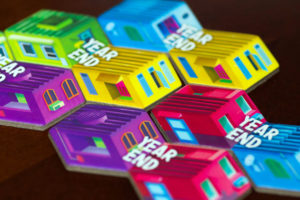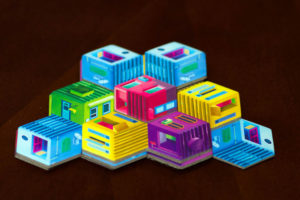 Tile laying games have long been a favorite of board gamers, going back to classics like Carcassone. These normally sprawling games have players laying tiles side by side, spread out widely over the tabletop. Favelas approaches tile laying in a different way. You are working to beautify the Brazilian favelas by building up. You never expand your area, but place tiles on top of your starting player board and existing tiles.
Tile laying games have long been a favorite of board gamers, going back to classics like Carcassone. These normally sprawling games have players laying tiles side by side, spread out widely over the tabletop. Favelas approaches tile laying in a different way. You are working to beautify the Brazilian favelas by building up. You never expand your area, but place tiles on top of your starting player board and existing tiles.
Favelas plays 2-4 players in about 30 minutes. I prefer the game at 2-3 players to decrease downtime between turns.
Gameplay Overview:
In Favelas, players attempt to beautify the favelas of Rio de Janeiro in a way to appease the city’s council. The game is played over three rounds and in each round, certain colors will be prized more highly, but players can influence which colors are in demand as well.

There are three double-favela tiles available to choose from a common supply. On your turn, you can choose one of those three double tiles, the top double-tile from the face down stack, or a single face down tile. You then add the favelas you’ve chosen to your personal board. Your favela only grows vertically, as you can never expand the size of your board. You must also keep the double tiles placed at an even height.
The main “Beautification Council Guidelines” board displays a die for each color of favelas available. This indicates the number of points you will score at the end of the round if you have (or are tied for) the majority of favelas of that color. There is also a clear die whose value is scored if you have at least one of each color displayed. If, when placing a favela tile, you cover up a color with the same color you must increase or decrease that color’s value by 1.
The game is played over three rounds. Each round ends when the “Year End” tile is revealed from the face down stack. The tile is randomly shuffled into the bottom 4 of each stack so that you are never quite sure where the end will come. Scoring takes place at the end of each round and then all of the dice are re-rolled to begin the next year. The player with the highest score is the winner.

Game Experience:
Favelas is an interesting tile laying game where you focus as much on what you are covering up in as well as what you are actually adding to your board. There is an interesting push/pull that goes on as you try to stay competitive in winning as many color majorities as possible. But obviously, you can’t win them all, so you also must do your best to make those that you can win worth a lot of points.
The change of building up, rather than out, also adds a neat dynamic to the game. You have to manage your levels carefully since you can’t place new tiles unevenly. The spatial element involved adds a unique touch that makes Favelas stand on its own quite well.

You only score points for having the most of each color, so you will spend a lot of time looking at the favelas of other players. It makes it almost impossible to plan very far ahead as the player before you not only eliminates one of the tiles you have to choose from, but also potentially changes which majorities you are going to be attempting to win that year.
It can certainly make the game crawl along a bit, especially at the higher player counts. It doesn’t take a long time to peek at one player board and see how their colors compare to yours. But when you start considering multiple players and the favela tiles you have available, and what options that will leave them with, you can really get yourself into a bit of analysis paralysis.

I am not a huge fan of the rolling of dice between rounds. Maybe it is meant to signify a whole new council being elected the next year with its own beautification preferences. But the value of colors can change dramatically or not at all. This doesn’t give players a lot of long-term strategy to be mindful of.
Each year is kind of its own mini-game and you just play three times and add up your scores and see who wins. Friendly ties allow for players to gang up a bit on the leaders, but there isn’t often a way to outscore opponents by large amounts—you really have to work hard to not have at least a couple majorities. For me, this left a little too much in the hands of the dice rolling during the beginning of the 2nd and 3rd years. Leaving them as-is presents challenges too, but I wish there was a little more volatility that players could control. Favelas feels like a tug of war—but no one is really able to pull all that hard.
Final Thoughts:
Favelas is a great looking, mostly abstract, tile laying game. It serves a role as a gateway level game that plays quickly and is easy to explain. Having to manage how tall you build up parts of your structure can be very important as you can limit where you can play tiles if you build extremely unevenly.
The decision making in Favelas just leaves a little to be desired for me personally. Perhaps some expansions could flesh out a little bit of long-term strategy options rather than just continually reacting to the colors your opponents are adding.
Final Score: 3 Stars – Looks great on the table and I really love the premise. However, I would prefer more impactful decision making in the hands of the players.
 Hits:
Hits:
• Easy to learn and play with gamers and non-gamers alike
• Building up adds a unique element to tile laying
Misses:
• Market values change randomly between rounds, but only can be slowly changed by players
• Hard to plan ahead as available tiles and opponent’s favelas change constantly






















